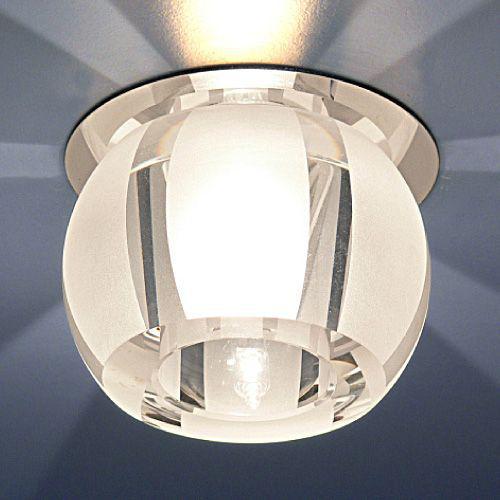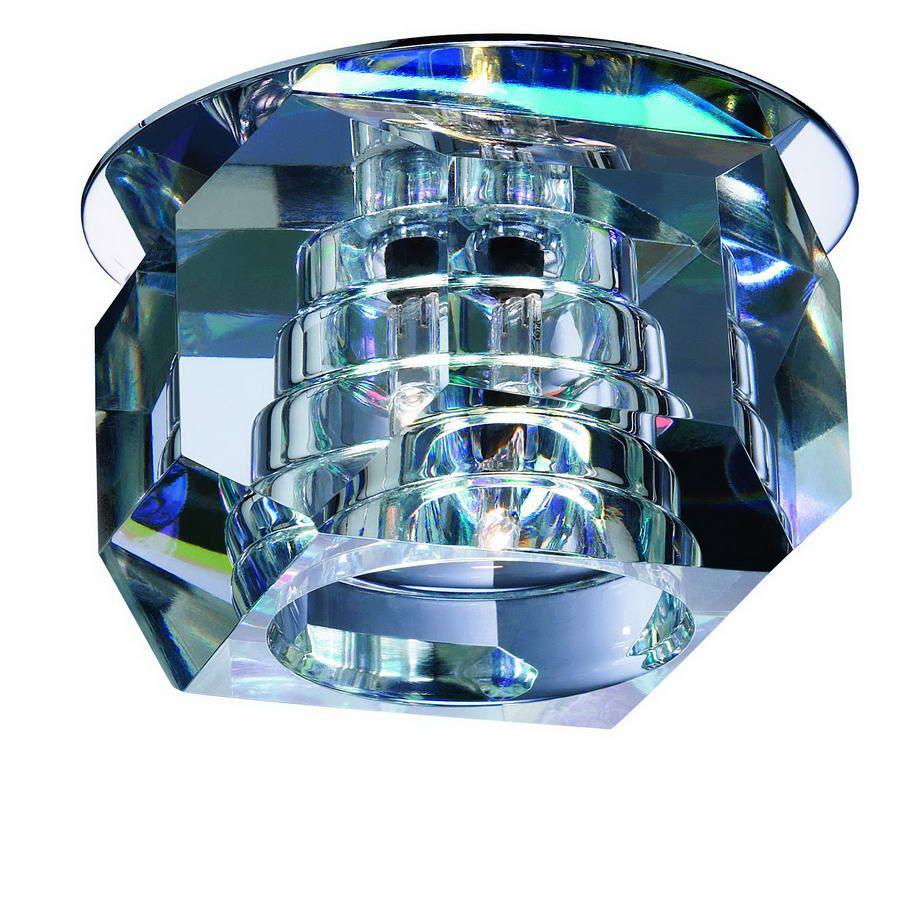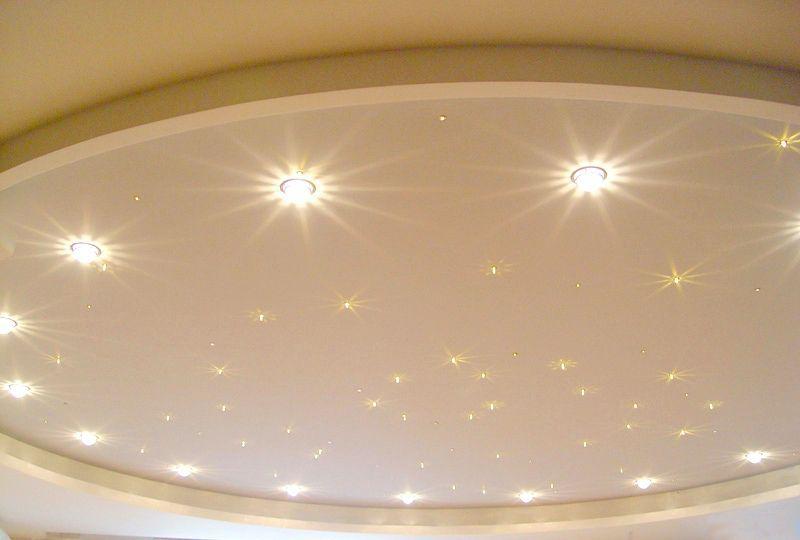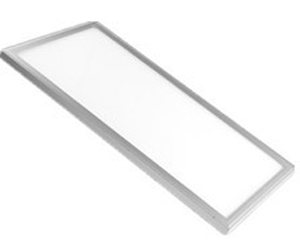When selecting built-in ceiling lighting Many factors are assessed, such as light brightness, efficiency, variety of designs, installation complexity, and operating requirements.
LED lighting, despite its considerable price, is gaining increasing popularity. Let's look at the reasons for this excitement.
Using built-in spot LED equipment, they illuminate:
- living quarters - rooms, bathrooms, toilets, kitchens;
- retail premises - directly trading floors, utility rooms and storage rooms;
- production areas;
- cafes, restaurants, offices;
- corridors, passages, landings and foyers;
- nightclubs, cinemas.
 Designer ceiling spotlight
Designer ceiling spotlight Lamps with LED lamps are installed in suspended ceilings.
Advantages and Disadvantages
LED lighting is considered the most promising among artificial lighting, eclipsing in its qualities halogen, fluorescent lamps and outdated incandescent light bulbs.
Advantages:
- The light is soft, without pulsations, diffused– does not create strain on the eyes, does not cause fatigue and is not harmful to health.
- Very long service life- from 30 to 50 thousand hours, which is 8 times more than halogen lamps and 30 times more than old incandescent light bulbs.
- Low power consumption, high efficiency. A 12W LED light produces the same amount of light as a 100W incandescent bulb.
- Instant on. LED lamps do not require time to warm up.
- The LED lamp does not heat up to high temperatures, because it works at low voltage. The risk of fire caused by LED lighting is minimal.
- They do not deteriorate when turned on frequently or from power surges.
Eco-friendly and safe. There are no breakable flasks, mercury, phosphorus or any other sources of chemical or physical hazards in the design. - Brightness adjustment possible light using a dimmer.
- Wide range of color temperatures. Keep in mind that warm yellowish light from incandescent lamps has parameters from 2700 to 3000 K, cold white light - 6500 K. The wavelength (binding) for all lamps of the same group should be the same. If the manufacturer does not pay attention to this parameter and does not indicate it on the packaging, there is a possibility that the light from several lamps of the same model will still differ.
- Wide design variations(adjustment of brightness and color spectrum) allow you to use LED lighting to focus attention on objects, separate functional zones one room, for decoration, main or background lighting.
- Manufacturers claim that A burnt-out LED can be easily replaced in the lamp.
 Light diode lamps allow you to create spotlights of the most bizarre shapes
Light diode lamps allow you to create spotlights of the most bizarre shapes Flaws:
- The most important disadvantage is price. Despite the increasing competition among manufacturers of diode lamps, the price remains quite high due to the design features.
- definitely has Quite a massive power supply. Together with the block, the lighting point weighs at least three hundred grams, so the quality of the holding fasteners becomes important.
- The recessed lamp unit must be hidden during installation. Pay attention to the minimum ceiling space required by the lamp model you choose.
- Throughout its long service life The LED gradually burns out, losing brightness. The worse the manufacturer has taken care of heat removal in the lamp, the faster the burnout process occurs.
- LEDs provide directional lighting. To illuminate a room evenly, you need to correctly distribute and install several units or even dozens of lighting fixtures. Used to adjust light brightness and create dynamic lighting effects.
However, most professionals consider such shortcomings to be negligible and see LED lighting technologies as the future.
Types of built-in lamps
Having understood the advantages and assessed the disadvantages, Let's start getting acquainted with the types of built-in LED lamps. They have structural differences, various shapes, base types, sizes.
Let's look at the main structural types LED spotlights:
- fixed;
- rotary;
- rotary and retractable;
- gimbals;
- spot;
- downlight.
Fixed lamps illuminate only part of the room. There is no way to adjust the direction of the light flow. Rotary lamps are mounted on embedded parts or special fixing metal clips. The light stream can be directed to the desired point. It is especially convenient to use this type of lamps in trading floor, where rearrangement is possible and periodically it is required to change the emphasis on one or another product group.
Rotary and retractable lamps can change the direction and width of the light flux to a greater extent than just rotary ones. By pointing a rotating and retractable lamp at the wall, you can create diffused, gentle lighting.
Cardan LED lamps have greater capabilities for regulating the strength and direction of the light flow. The main difference is that the gimbal lamp body is designed to accommodate several LED lamps.
Installing LEDs different colors owing spectra or power, designers achieve very unusual effects.
Spot is a lamp with a rotating mechanism that produces a directional flow of light. Often done at several points of light.
Downlight– if translated literally, the term means light directed downwards.
Built-in spot lighting can be installed in various types of suspended ceilings: plasterboard or MDF panels, wood or PVC. Various models LED lamps have different requirements for the size of the inter-ceiling space.

Built-in light shape:
- round;
- oval;
- square;
- triangular;
- can be rectangular;
- modern designers do not stop at correct geometric shapes and borrow from nature the outlines of starfish, flowers, leaves...
Case design:
- metal – chrome, gold, silver, bronze, iron, matte or polished;
- colored plastic;
- crystal;
- decorative glass;
- under the tree;
- in antique style;
- under stucco;
- with colored glaze;
- with Swarovski crystals...
When choosing a model of a recessed LED lamp, pay attention to the following parameters:
- dimensions of the outer case;
- mortise diameter;
- mortise height;
- rotation angle (for rotating lamps);
- power;
- cartridge/base;
- protection from moisture (if you plan to install it in a bathroom);
- dimmability;
- remote control.
Lamp power can be selected based on the following table for matching lighting brightness.
Types of base for lamps of recessed LED spotlights are most often of the following types:
- E14, E27;
- G4, G9, G13, G53, GU4, GU5.3, GU10, GX8.8, GX53.
The letter E in the base type designates the thread, B is the pin mount, G is the designation for the pin group of bases, the second letter is the specific modification of the lamp, if several are produced. The number on the right indicates the diameter of the base in millimeters or the distance between the pins.
Even if it is physically possible to connect a lamp that is not indicated as suitable for a given type of lamp, this should not be done. Various types lamps are not always interchangeable. When replacing a lamp, be sure to check the information about the types of bases compatible with your lamp.
 Complex shapes help lamps with diodes to diffuse light in a special way
Complex shapes help lamps with diodes to diffuse light in a special way  LED spotlights help create color effects
LED spotlights help create color effects Price
The cost is influenced by the following factors:
- Country of manufacture- labor in different countries is valued differently and makes up the lion's share of the cost of any product.
- Quality of main materials– fastenings, power supply, diffusers.
- Materials for the design of the case – external finishing may include expensive Swarovski crystals or crystal.
To compare the price range, let’s take several models of recessed luminaires from the same famous manufacturer, which can be bought in Moscow.
Installation and connection
Electrical wiring must be laid in a box suspended ceiling still at the stage of its installation. It is advisable to provide additional insulation and lay the wires in a box or pipe of small diameter.
 Device ceiling lamp with diodes and the principle of installation in a suspended ceiling
Device ceiling lamp with diodes and the principle of installation in a suspended ceiling For ceilings made of MDF panels or plastic ceilings special fireproof wires must be laid. Their cross-section is selected based on tables that take into account not only the total power of the light bulbs, but also the length of the electrical wiring, the number of points, etc.
The lamp consists of the following parts:
- housing with or without diffuser;
- cartridge with wires;
- terminal block;
- LED lamp;
- Metal lamp holder.
- We mark the points on the ceiling where we plan to install the lamps.
- We put a crown equal in size to the mortise diameter of the lamp on a drill or screwdriver and cut holes in the suspended ceiling.
- Turn off the electricity.
- For each hole, get the wires laid in the suspended ceiling box.
- We clamp the wires from the lamp socket and the supply wires into the terminal block, observing the zero/phase correspondence.
- We bend the special spring fasteners of the lamp and, without allowing them to return to their original position, we place the lamp in the mounting hole until it stops. The fasteners will separate and tightly fix the lamp body.
- We take the socket out of the niche and insert the lamp into it.
- We insert the socket and the light bulb into the lamp body, fix it with a metal ring, inserting it into special grooves under the lamp.
- You can turn on the lights and check your work, as well as adjust the angles that direct the luminous flux of the rotating lamps.
Watch the video that shows how to install and connect.
Turning off the electricity with just a switch may not be enough. There are cases when the switch breaks not a phase, but a zero. It is better to de-energize the desired room on the panel.
Features of installing recessed LED spotlights in different types ceilings:
- Suspended ceiling. The lamps are attached to load-bearing structure. Moreover, the holes are cut only after the fabric is stretched. A reinforcing and thermal insulation ring is installed around the hole for the housing. Important! Diode lamps with a power exceeding 35 W cannot be installed in suspended ceilings to avoid deformation or fading of the stretch coating.
- Slatted ceiling. Electrical wiring and installation of lamps are carried out simultaneously with the installation of the slatted ceiling. If there is not enough space between the ceilings, wooden beams can be used to increase it.
- Cassette ceiling. All electrical wiring must also be placed in insulating corrugated boxes and attached to the main ceiling. The cassettes must be strong enough to support the weight of the spotlights.
Good to know: - It is advisable to install lamps from the same manufacturer in the same room on the same electrical wiring. Make sure that the lamp has a reflector and a cooling element along the contour of the body - these are mandatory elements of a high-quality LED lamp.
- In suspended ceilings It is not recommended to use lamps with a power exceeding 40 W. No matter how wonderful LEDs are, there is still a certain heat transfer. The higher the lamp power, the greater the heating of the lamp. Over time, the ceiling may deteriorate. It is better to install several lamps of lower power than one powerful one.
- Compact fixtures may require a step-down transformer. When choosing a transformer, consider the total power of all lamps that you plan to connect to it.
- There are recommendations for placement density of spotlights. For example, for rooms with a ceiling of 2.5 meters, lamps are installed no further than 60 centimeters from the wall or partition. If the ceiling design includes several rows of lamps, leave no more than a meter between the rows.
 An example of ceiling lighting design with LED spotlights (photo)
An example of ceiling lighting design with LED spotlights (photo) Recessed LED ceiling lights – great solution both for the apartment and for other premises. The high price quickly pays off due to energy savings and the long service life of LEDs. The market today provides the widest model range how about design features, and by design.
They are the most economical way to make your apartment original and bright. They have the following advantages:
- Economical. Light output from ceilings LED lamps is achieved at 120 lumens per watt of consumption. For halogen and incandescent lamps best indicator equals only 24 lumens per watt.
- Long service life. In theory, for LEDs it can reach up to 72 thousand hours. However, this is just the projected lifespan of the LEDs themselves. Exist for too little time modern LED lamps to confirm this theory in practice. In addition, power converters and stabilizers are much less reliable.
The spectral characteristics of the LED depend on the composition of the semiconductor. Without using additional filters, you can create any color of emitted light.
- they emit light in the desired direction, without the use of reflectors or reflectors. Focusing of the light flux and re-reflection is necessary for any alternative light sources, which will mean additional losses in brightness.
- When working or destroying in terms of release harmful substances(they are completely absent in LEDs) and in case of voltage damage (LED lamps are powered by 12 or 24 volts) are absolutely safe LED lighting.
- have low heat generation, without worrying about overheating, they can be safely installed in a suspended ceiling with minimum clearance until overlap.
- This type The lamps have negligible inertia; without a pause to warm up, they immediately light up. The lamps are also resistant to cyclic loads. After all, most often incandescent lamps burn out when they are turned on, the same happens with energy-saving, fluorescent and halogen lamps(the more often the lights turn on and off, the shorter their service life will be). For LED lamps no relationship was observed between the number of on-off cycles.
For simple calculation the required number of lamps, use the Calculator for calculating the number of lamps.
But besides the undoubted advantages, they have several disadvantages:
- The first and main disadvantage is the price. Although LED light sources in the last couple of years they have fallen sharply in price, but they are still the most expensive in terms of lumen of lighting.
- The LEDs are powered by low voltage direct current. That's why recessed LED lights They are equipped with their own power converter and stabilizer or are powered from a common external power supply, or use a series connection of LEDs and a diode bridge. Cost is affected by the first two decisions, and resiliency is affected by the last.
- Even with their high efficiency, powerful lighting LEDs still generate noticeable heat. Limited to 100C operating temperature LED, so at least a heatsink is required in such cases.

Having studied all the advantages and disadvantages, we can conclude that the advantages overwhelmingly outweigh the disadvantages. If the price still doesn’t scare you, then suspended ceilings have a huge advantage over others lighting fixtures have recessed LED lights.
Shapes of recessed LED lamps.
Typical shape of recessed LED luminaires- round.
1. Cut out round hole a crown or jigsaw in the surface of a suspended ceiling;
2. Power wires are released through it;
3. The lamp terminals are connected to them;
4. The lamp is inserted into the hole and fixed there with its own spring-loaded clamps.
Power of recessed LED luminaires.
The typical power of solutions of this kind lies within the range of 3 - 10 Watts. White LEDs are the most commonly used.
Recessed light panels.
Most often, light panels are used in industrial and office premises, not residential premises; decent dimensions and high luminosity are the reason for their use for these types of premises. To replace built-in lamps with fluorescent lamps, which remain the most popular today warehouses, as well as in department stores, LED panels are available.

Ceiling lamps made in the form of panels can theoretically be built into any suspended ceiling, regardless of its material.
Light panels There are different sizes: 170x606 mm, 300x300 mm, 295x1195 mm and so on.
But the most common and popular size is 595x595 mm, this is the size of standard mineral fiber or gypsum tiles for the Armstrong cassette suspended ceiling, which is the leader in popularity among office ceiling systems.

Installation of light panels dictated by the form factor. The panel, as a rule, is simply laid in a prepared groove on plasterboard or in the ceiling sheathing; panels with a diameter of 595x595 mm, along with other tiles, are laid in rack and pinion system. Next, you need to connect the pre-wired power supply and the panel will be completely ready for operation.
Power of recessed LED luminaires, having the form of a panel depends on the number of LEDs in the panel and it is directly proportional to the price of the product. Consumption up to 80 Watts with a luminous flux of up to 5500 lumens, the most popular models have. It is possible to produce more powerful products, but due to their exorbitant cost, there is unlikely to be much demand for them.

The advantages that recessed LED lamps have are obvious; as production increases and prices decrease, they will be guaranteed to displace all competing solutions from the market.
Recessed LED spotlights (spots) can be installed in any room. Lamps can fully replace a chandelier, sconce, or be used as additional interior lighting.
Models differ in:
- Scope of application
- Type and size of base
There is a wide variety of shapes and styles of built-in lamps from classic to high-tech - round, square, flat and volumetric. There are lamps different diameters and can hold up to 30 lamps.
Used to make lamps various materials: ceramics, metal or glass. The main task of the case is to dissipate heat. Aluminum is best suited for this function. Remember that in addition to high heat transfer, the model’s body must be moisture-resistant and durable (for example, if you install it in a bathroom).
When choosing glass lamps, you should pay attention to the transparency of the glass. Frosted glass gives diffused and muted light, transparent - directed and bright.
Type:
- Fixed.
- Rotating (can change the direction of light).
Types and sizes of socles:
Recessed LED luminaires work with a G-type socket. It uses pin system(she connects the lamp to the socket).
- G53 for directional lighting and creating accents in the interior. Diameter 70 mm.
- GX53 for suspended and suspended ceilings. Diameter 53 mm. The models operate on direct current and do not require transformers.
- G5.3 is the most popular type of LED lamp base for household and decorative lighting.
Advantages:
- Durability. Service life up to 50,000 hours.
- Low power consumption. LEDs are 10 times more economical than all existing analogues.
- High light output. Unlike fluorescent lamps, LEDs provide uniform illumination (do not flicker). Thanks to this, your eyes become less tired. Also, such lamps are suitable for lighting structures with rotating elements. They do not have a stroboscopic effect. All details are clearly visible.
- Wide palette. LED lamps They come in different colors, and with some imagination, you can decorate the room in any tone.
LED panels- These are built-in or surface-mounted ceiling LED lamps that provide uniform illumination over the entire surface of the diffuser. This effect is achieved by placing LEDs around the perimeter. The light, reflected from the back cover onto a special lighting glass, creates the effect of uniform illumination over the entire area of the diffuser and does not give a “dazzle” effect. Light panels are available in built-in or surface-mounted types. Regardless of the type of installation, the shape of the lamp is usually square or round.
Thin LED Panels, as well as ultra-thin LED panels are recessed luminaires. Their main advantage is their small thickness. This makes it possible to reduce the distance between the main and suspended/stretch ceiling and, thus, maintain the maximum volume of the room.
Overhead LED panels - used where the creation of a false ceiling system is not envisaged. They differ positively from conventional lamps in their more elegant design, smaller dimensions and quality of lighting. In conventional overhead LED lamps, the LEDs are located on the back cover and, accordingly, they shine better only under them, and overhead panels provide more even illumination of the entire area.
Recessed downlights (downlight). In front of everyone positive aspects LED panels, they all have one feature - relatively low power and large losses due to reflected glow. It is useless to install them in rooms with high ceilings. In such cases, it is more relevant to use recessed downlights. Due to the directed light vertically downward, such lamps can be used in rooms with high ceilings. This is, for example, shopping centers, concert and exhibition halls, where it is especially necessary elegant design lamps and high energy efficiency.
The main advantages of LED panels and type luminairesdownlight:
- Elegant modern design. You can easily choose a lamp to suit your interior.
- Low power consumption. The energy consumption class of LED lamps and panels is the highest (A or A+).
- Possibility to choose the color of the glow. You can choose neutral white, warm white or cool white for your application white glow. Regardless of the color shade, you will receive a high color rendering index.
- No harmful flicker. We offer only high-quality certified products famous brands with guaranteed stable quality.
- When purchasing an LED panel or downlight, you do not need to buy anything additional for connection.
- Easy to install. To install LED panels or downlights, you don’t even need to involve specialists. You can do this yourself using the instructions that come with each lamp.
- They do not require maintenance during their entire service life. Average term The service life of the LED module is several times longer than the warranty period.





